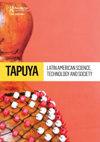Finding one’s way in media and AI: metallurgy and mapping
IF 1.2
Q2 HISTORY & PHILOSOPHY OF SCIENCE
Tapuya: Latin American Science, Technology and Society
Pub Date : 2022-12-31
DOI:10.1080/25729861.2021.1992959
引用次数: 0
Abstract
That which is most palpable of media devices – a uniform tactile screen or the sleek casing of a smartphone – often renders less visible the complex materiality of that technology. Similarly, when speaking about artificial intelligence (AI) and its apparent ability to learn, buzzwords and phrases gloss over a careful understanding of how AI works and how it arose. Jussi Parikka and Kate Crawford concern themselves with ostensibly distinct matters: the former explores what it means to think of media geologically in A Geology of Media, while the latter investigates the history and discourse surrounding AI in Atlas of AI. Nonetheless, Parikka and Crawford coincide in the thrust of their projects: there is a particular theoretical potential in media devices and artificial intelligence that is not obvious in their final, packaged form. Parikka proposes a “metallurgical way of conducting theoretical work” that foregrounds nonhuman, geologic agency in the production of modern media technology. He calls attention to the geologic materiality of media through literature, art and theory: transdisciplinarity is central to the metallurgic method. Crawford adopts a cartographical approach, cutting through the mystique of AI by mapping out what AI is, what it is not, and how it has come to wield an air of unknowable abstraction. Through their respective methods, both books seek to (re)-ground media, intelligence, and discourse and begin anew.在媒体和人工智能中找到自己的道路:冶金和制图
媒体设备中最明显的东西——统一的触觉屏幕或智能手机光滑的外壳——往往会让这种技术的复杂物质性变得不那么明显。同样,当谈到人工智能(AI)及其明显的学习能力时,流行语和短语掩盖了对人工智能如何工作以及它是如何产生的仔细理解。Jussi Parikka和Kate Crawford关注的是表面上截然不同的问题:前者在《媒体地质学》中探讨了从地质学角度看待媒体的意义,而后者在《人工智能地图集》中研究了围绕人工智能的历史和话语。尽管如此,Parikka和Crawford在他们项目的主旨上是一致的:在媒体设备和人工智能中有一种特殊的理论潜力,这种潜力在它们最终的包装形式中并不明显。Parikka提出了一种“进行理论工作的冶金方法”,在现代媒体技术的生产中突出了非人类的地质机构。他呼吁通过文学、艺术和理论来关注媒介的地质物质性:跨学科是冶金方法的核心。克劳福德采用了一种制图的方法,通过描绘出人工智能是什么,不是什么,以及它是如何产生一种不可知的抽象氛围,来揭开人工智能的神秘面纱。通过各自的方法,两本书都试图(重新)定位媒体、情报和话语,并重新开始。
本文章由计算机程序翻译,如有差异,请以英文原文为准。
求助全文
约1分钟内获得全文
求助全文
来源期刊

Tapuya: Latin American Science, Technology and Society
Social Sciences-Social Sciences (all)
CiteScore
1.60
自引率
0.00%
发文量
39
审稿时长
19 weeks
 求助内容:
求助内容: 应助结果提醒方式:
应助结果提醒方式:


